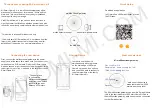
Section 8 DETAILED MENU REFERENCE
121
DIAL
As the name implies, this menu is used to dial calls with Zephyr’s internal terminal
adapter. The number of the receiving party is manually entered and you can select
whether you are placing a high- fidelity call via ISDN or a voice- grade call to a Plain Old
Telephone Service (POTS) phone.
AUTO-DIAL
This menu is used to place calls to frequently accessed numbers stored as auto-
dial setups. While you can verify the recipient’s number, codec settings, and
transmission rates from the AUTO- DIAL menu, you cannot make changes. All changes
to the auto- dial setups are accomplished from the UTILITY menu.
DROP
From this menu, calls placed using the DIAL and AUTO- DIAL menus are terminated.
VOLUME
Audio levels for the front panel headphone jack and telephone monitoring
speaker are adjusted from this menu. In addition, the VOLUME menu can be used to
adjust the level of the input audio to be sent to the digital network.
HELP
The HELP menu provides brief descriptions of all of the Zephyr menu items, as well as
information on other status information displayed on the LCD display.
It can be accessed at any time by simply pressing the <HELP> button on the
front panel.
Using the Menus
Accessing a menu is as easy as pushing a button on the front panel. All menus, except
the HELP menu, operate in the same manner.
When you initially select a menu, you see a display of up to three menu items on the
four- line LCD display. Each of the menu items displays its name on the left and its
current setting on the right.
Brackets around a setting indicate that this menu item is currently available for
modification. To select a different menu item, use the <SELECT
$
> and <SELECT
#
>
buttons. The brackets move up and down to indicate the selected menu item.
To change the settings of any menu item, the <NO (- )> and <YES (+)> button are used.
The fourth row of the LCD display describes how to change the settings of the selected
menu item using these two buttons.
DETAILED MENU REFERENCE
Summary of Contents for Zephyr
Page 13: ...Table of Contents 13 SECTION 1 QUICK RESULTS ...
Page 26: ...Section 2 INTRODUCTION 26 This page intentially left blank ...
Page 27: ...Section 2 INTRODUCTION 27 SECTION 2 INTRODUCTION ...
Page 38: ...Section 2 INTRODUCTION 38 This page intentionally left blank ...
Page 39: ...39 SECTION 3 ZEPHYR AT A GLANCE ...
Page 52: ...Section 4 INSTALLATION BASIC OPERATION 52 This page intentionally left blank ...
Page 53: ...Section 4 INSTALLATION BASIC OP 53 SECTION 4 INSTALLATION BASIC OPERATION ...
Page 84: ...Section 4 INSTALLATION BASIC OPERATION 84 ...
Page 85: ...Section 5 ISDN 85 SECTION 5 ISDN ...
Page 105: ...Section 6 NON ISDN NETWORKS 105 SECTION 7 AUDIO CODING ...
Page 118: ...Section 7 AUDIO CODING PRINCIPLES 118 This page intentionally left blank ...
Page 119: ...Section 8 DETAILED MENU REFERENCE 119 SECTION 8 DETAILED MENU REFERENCE ...
Page 157: ...Section 9 REMOTE CONTROL 157 SECTION 9 REMOTE CONTROL ...
Page 176: ...Section 9 REMOTE CONTROL 176 This page intentionally left blank ...
Page 177: ...Section 10 ADVANCED PROBLEM SOLVING 177 SECTION 10 ADVANCED PROBLEM SOLVING ...
Page 196: ...Section 10 ADVANCED PROBLEM SOLVING 196 This page intentionally left blank ...
Page 197: ...Section 11 TECHNICAL INFORMATION 197 SECTION 11 DETAILED TECHNICAL INFORMATION ...
Page 219: ...Section 12 SCHEMATICS 219 SECTION 12 SCHEMATICS ...
Page 221: ...Section 13 MANUFACTURER S DATA SHEETS 221 SECTION 13 MANUFACTURER S DATA SHEETS ...
Page 223: ...Section 14 SPECIFICATIONS WARRANTY 223 SECTION 14 SPECIFICATIONS AND WARRANTY ...
Page 228: ...228 This page intentionally left blank ...
Page 229: ...Section 15 APPENDICES 229 SECTION 15 APPENDICES ...
















































